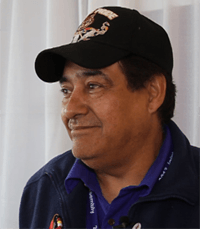Q&A with The Rev. Richard Bruyere(Diocese of Keewatin)

CNC: Tell me the name of your community.
RB: Sagkeeng First Nation. It’s near Pine Falls, on the mouth of the Winnipeg River. And Sagkeeng means “mouth of the river”—where the river runs into the lake.
CNC: And tell me about the community you minister to there.
RB: There’s about 5000 people there. My wife Nancy and I, we’re both priests there. We look after four communities: three First Nations communities and one Metis community. And they’re close together: Sagkeeng First Nation, Little Black River, Hollow Water and Manigotagan.
CNC: And what are the communities like? Are there jobs there, growing communities?
RB: They’re growing communities, but they are struggling. Jobs are very few. We had a paper mill there, it shut down a few years ago.
CNC: So that affects the church too.
RB: It did affect the church, yes. Especially the church in Pine Falls—Church of the Advent—it closed down.
CNC: And where did you and your wife receive your training?
RB: We studied at the William Winter School of Ministry in Kingfisher—we were there 4 years.
CNC: Did you go and live there?
RB: It was an intensive course where you go 2 weeks twice a year for 4 years.
CNC: And what was that experience like?
RB: It was very good—I really liked it because it was hands-on, right in the community and it was more the kind of ministry that we do.
CNC: And is your first language Cree?
RB: No, we’re Ojibway…But Kingfisher is Oji-Cree, so I understand their language.
CNC: The classes at William Winter were in English though?
RB: They’re all in English…but there were a few classes where they taught Oji-Cree and also syllabics. It was good, I really liked that.
CNC: What about your personal story—were you baptized an Anglican? Did you always attend church? How did you come to be a priest?
RB: Personally, I was baptized in the Roman Catholic Church. And in our community there was a Catholic-run residential school. I attended that school. And my wife, she was baptized Anglican. Then when I met her, I started going to their church and it related to me. The priest there was Rev. Andrew Sinclair, and he spoke our language and when he preached, it related to the aboriginal people and I really liked it. So I started attending more and more. And I first helped with Nancy in the Sunday School. With the children we started with hymns, Christmas hymns. So that’s how we started: every Christmas we would get the youth to sing the Christmas pageant, so that’s how I started helping her. Then I got more interested.
CNC: So what difference has it made in your life—your connection to the Anglican Church, your faith in Jesus?
RB: Well me personally, it saved me. It saved my life, especially the way I was before…I thank God for that.
CNC: So it was a big change in your life?
RB: It was a big change, yes. At the time when I was younger, I was rebelling because of the things that happened in residential school and a lot of the other things that as being Aboriginal, that we face. But as I came back to church, it really helped me—and that’s when my healing—inside, my healing—started. That’s why I say “It saved me.” And I thank God for that.
CNC: And what does it mean to you as a priest and to your community that you have support through the Council of the North and support from the rest of the Church?
RB: It helps us a lot. One of the things that really helps us is that we’re not alone. There’s a lot of other people in our position, clergy, facing the same things. And we tell each other stories and that’s a support for us. People like Rev. Larry Beardy and Bishop Adam Halkett, we work along with him too.
CNC: Tell us a bit about Sacred Circle. Did you attend?
RB: My wife attended Sacred Circle, it was in Pinawa. I was only there for two days. Nancy and I, we’re non-stipendiary priests and I had to work that week. I work for the Provincial government on the East Side Road Authority—I’m an engineer. We’re building an all-weather road on the east side of Lake Winnipeg and I had to work. But I was able to attend the first day and the last day of the Sacred Circle.
CNC: So what is that like if you hold a regular job and then you do ministry and you have to fit it in around that—is that challenging?
RB: It’s very challenging.
CNC: People call any time.
RB: Yes, all hours of the night sometimes: 2:00, 3:00 in the morning we get a call from relatives or people that are sick in Winnipeg so we have to rush to Winnipeg—it’s an hour and a half drive to Winnipeg. And there’s some people from northern Ontario—when they ask for a clergy, they phone us up. So we go there.
CNC: Because many people from northern Ontario get sent to Winnipeg…
RB: So we get called to Winnipeg and we go pray for people in the hospital and it is challenging…but it’s also very rewarding.
Interested in keeping up-to-date on news, opinion, events and resources from the Anglican Church of Canada? Sign up for our email alerts .
